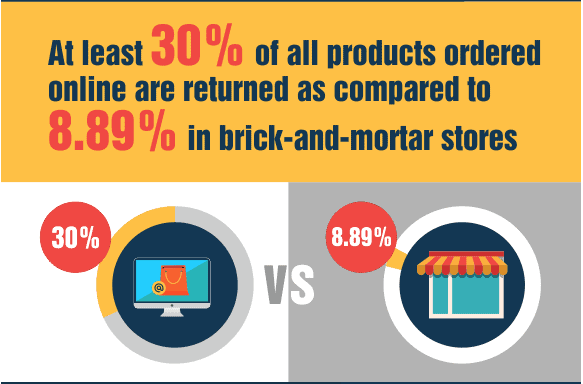Product returns can be a big menace for retailers as they can dig into the business’s profits and be a significant financial burden.
The problem is more prevalent with online retailers as the process of returns gets much simpler for the customers. Studies show that at least 30% of all the products purchased online are returned, compared to 8.89% for brick and mortar stores.
In the case of eCommerce businesses, the charges for reverse shipment of the returned products add up. Hence, it is imperative that you find a way to reduce product returns and find ways to tackle increased returns.
In this article, let’s look at some of the most effective strategies that top eCommerce retailers use to reduce their product returns and improve ROI.
1. Add Comprehensive Product Information
Did you know that the second most common reason customers return products is that the products they received looked different from those on the website?
This is a very common complaint raised by eCommerce customers, and tackling this can drastically reduce your product returns.
Here are some ways in which you can ensure that your product information is detailed enough:
- Add comprehensive and accurate product descriptions for each product. Make sure that you include dimensions, size charts, color, shape, safety precautions, and every other detail that the customer may be interested in.
- Add high-resolution images of your products. Ensure that you cover all angles of the product.
- You can also add product demo or unboxing videos to make sure that the customer knows exactly what to expect.
- You can also use augmented reality to help the customers picture your products well.
2. Offer Easy Exchange Policies
 Having tough exchange policies may be one of the biggest reasons for increased product returns. By offering easy product exchange policies, many of your customers may switch to exchange instead of returns.
Having tough exchange policies may be one of the biggest reasons for increased product returns. By offering easy product exchange policies, many of your customers may switch to exchange instead of returns.
So, try to craft easy and hassle-free exchange policies, and the most important part – let your customers know about it. Provide easy access to your exchange terms and conditions from your home page. Also, try to add detailed information about product exchanges on each of your product pages.
You can also set up a prompt for product exchange when the user tries to return products from your website or mobile app. Following these steps will let your customers know about how easy your exchange options are, and this will lead to reduced product returns.
3. Ensure Stringent Quality Checks
The top reason for product returns is that the customers received damaged products. So, how do you handle this? By ensuring stringent product quality control and setting up the right inspection criteria.
You should ensure thorough quality checks for your products if you are handling order fulfillment in-house or even if you are outsourcing it to vendors. Either way, you can have Standard Operating Procedures (SOPs) in place to make sure that there are strict inspections after the shipment arrives and before the product picking is scheduled.
You can have inspection criteria that help you filter out products that are of sub-par quality, different colors, different sizes, expired, spoiled, etc. You should also make sure that the product exactly matches the product description and images on your website.
Having stringent quality checks in place will help you deliver good quality products and the right ones to your customers most of the time. This will automatically lead to a reduced number of product returns, happier customers, and increased ROI for your business.
4. Track and Manage Product Returns
As a small eCommerce business, you might be hesitant to automate your order fulfillment process and invest in a returns management system. However, automated tracking and management of returns can be pivotal in reducing your product returns to a great extent.
Having consolidated data on your product returns will help you identify the products with the highest return rates. Using this data, you can help analyze the problem with the product and take measures based on the return reasons.
Not just this, using a returns management system, you can also identify customers who are frequently returning your products. If you find this as a recurring pattern, you can flag such customers and send them a warning message so that they stop frequent product returns.
5. Offer Outstanding Customer Service
 Sometimes, customers may return products due to a lack of knowledge or assistance. For example, if a customer doesn’t know about your easy exchange policies, they may end up returning the products rather than exchanging them. In such a case, customer service can help you intervene and urge the customer to exchange the product.
Sometimes, customers may return products due to a lack of knowledge or assistance. For example, if a customer doesn’t know about your easy exchange policies, they may end up returning the products rather than exchanging them. In such a case, customer service can help you intervene and urge the customer to exchange the product.
Another example would be the case where a customer receives a product that is not of good quality. In such a case, the customer’s first instinct may be to return the product. But, by being proactive with your customer service, you can contact the customer, apologize for the quality and convince them for a product replacement.
Therefore, ensure that you are proactive with customer support. When a customer asks for a return, you can provide options to chat with customer service to offer product replacement. You can also integrate an AI chatbot with your website or reach out to customers via emails asking them to contact you in case they are not satisfied with the products.
6. Collect and Incorporate Customer Feedback
Understanding the root cause for an increased number of product returns can be another way to make amends and improve your ROI. For identifying the root cause, you can gather feedback from your customers.
You can ask for customer feedback through emails or through in-app messaging. You can gather feedback from social media platforms where your customers may leave reviews or feedback about your products. You can also analyze your returns data to analyze the most prominent reason for returns.
Using the gathered data and feedback, you can try to make amends to your process and products. For example, suppose you see that customers are increasingly complaining about a particular product running a size higher. In that case, you can make changes to the size chart accordingly so that customers always find the right size, leading to reduced product returns.
Bottom Line
Product returns can be a major reason for reduced ROI for your eCommerce business. If you do not reduce the returns rates for your products, you might lose a huge chunk of your profits.
The strategies provided in this guide are actionable and effective. By implementing these, you’ll definitely see reduced return rates and better profitability for your eCommerce business.

